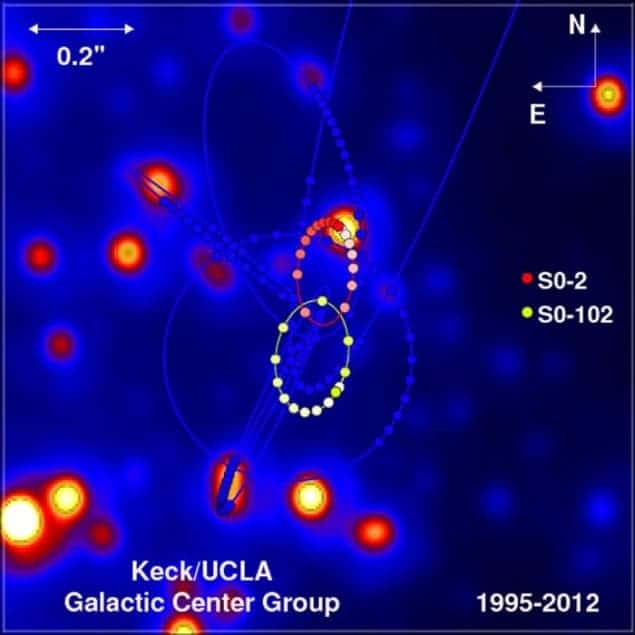
Astronomers using the Keck telescope have found a new star orbiting very near to the supermassive black hole believed to be at the centre of the Milky Way. This is only the second star that researchers have observed completing an entire orbit – and its discovery confirms the black hole’s presence beyond reasonable doubt. Future observations of both orbiting stars could provide a unique test of general relativity.
The Keck telescope atop Mauna Kea in Hawaii has been used since the mid-1990s to systematically probe the area surrounding the centre of the Milky Way. In doing so, astronomers revealed several stars that appear to be orbiting a central object dubbed Sgr A* (“Sagittarius A Star”). From measurements of the stars’ orbital characteristics, it was calculated that Sgr A* must weigh in at around four million times the mass of the Sun. The only known astrophysical object that could be so massive, yet exist in such a small space, is a black hole.
However, only the orbit of one star – S0-2 – had data covering its entire 16.5 year journey around the centre. Data on the rest of the stars cover less than 40% of their orbits – the remainder has been projected using modelling. In order to characterize an orbit, astronomers believe that 50% of a star’s orbit needs to be observed. With only S0-2 breaking this threshold, some sceptics questioned whether a central black hole existed at all.
Better adaptive optics
Now, astronomers, including Andrea Ghez at the University of California, Los Angeles, have revealed the discovery of a new star named S0-102. “The orbital period of this star is just 11.5 years – the shortest of any star known to orbit the black hole,” Ghez told physicsworld.com. “Improvements in adaptive optics have allowed us to find fainter stars and measure them more acurately,” she says. With adaptive optics, the telescope’s mirror is not a single surface, rather a tiled surface made up of smaller mirrors. A laser guide is fired into the sky above the telescope and the distortion of the laser due to atmospheric turbulence is measured. The shape of the mirror can then be adapted by moving individual tiles in order to compensate for the distortion.
This technique will also allow the future observation of S0-102 at apoapsis – its furthest distance from the black hole. “This will reduce our uncertainties in parameters like the black hole’s mass,” says Ghez. Having a second star to observe will also allow astronomers to improve their understanding of S0-2’s orbit. In particular, it will help provide a more precise measurement of S0-2’s periapsis – its closest approach to the black hole – in 2018. During periapsis, the star experiences a stronger gravitational force, causing an additional redshift in its light. The precise amount of redshift is predicted by Einstein’s general theory of relativity. The experiment can be repeated when S0-102 reaches its own periapsis in 2021.
General relativity also predicts the precession of a star’s periapsis. “The fact that space is warped by the gravity of the black hole means that orbits overshoot each time. The point of periapsis moves on in the direction that the star is already orbiting,” explains Ghez. This is similar to the precession of Mercury’s orbit within our own solar system – a puzzle that, when explained by Einstein in 1915, provided an early endorsement of his ideas.
Unknown parameter
However, this particular test of relativity is not possible with a single star. “The situation isn’t as simple as two stars orbiting a single black hole,” says Ghez. “There are likely to be other things orbiting in there too, such as stellar-mass black holes and neutron stars,” she adds. This means that the orbiting stars do not see a symmetrical distribution of mass as they pass through this crowded region. If general relativity is to be tested, it has to be treated as an unknown parameter. If the mass distribution is also unknown, you need two stars to solve the equations. “With future advances in adaptive optics, and the next generation of telescopes, we will now be able to see whether Einstein’s relativity stands up in this extreme gravitational environment,” Ghez hopes.
“It is pretty spectacular that they’ve observed the whole orbit of a second star,” Nils Andersson, head of the General Relativity Group, at the University of Southampton, UK, says. “It shows there has to be a black hole in the centre, and it helps pinpoint how massive it is,” he adds. However, he believes there are stronger tests of general relativity. “I think the best test beyond the solar system is still two pulsars orbiting around each other. That sort of system puts more constraints on Einstein’s theory,” he explains.
The observations are described in Science.



